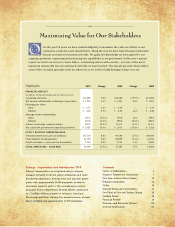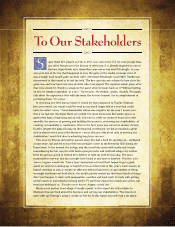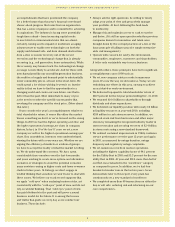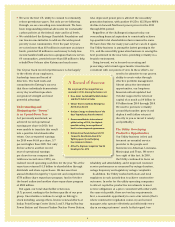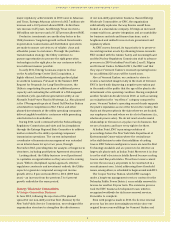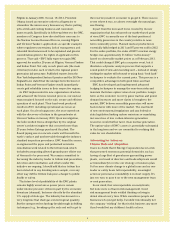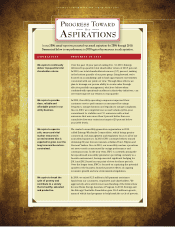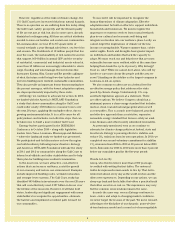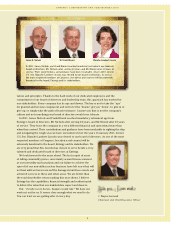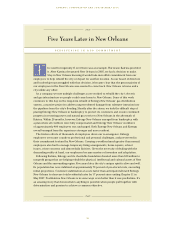Entergy 2010 Annual Report Download - page 5
Download and view the complete annual report
Please find page 5 of the 2010 Entergy annual report below. You can navigate through the pages in the report by either clicking on the pages listed below, or by using the keyword search tool below to find specific information within the annual report.
ENTERGY CORPORATION AND SUBSIDIARIES 2010
accomplishments that have positioned the company
for a better future than this year’s fi nancial scoreboard
shows; about progress that came from an organization
that has a sense of purpose and is committed to achieving
its aspirations. The industry is facing some potentially
tough times ahead – from increasing capital needs
to meet stricter environmental rules that are almost
certainly coming and to expand or modernize an aging
infrastructure to enable new technologies on both the
supply and demand side, and from demand destruction
from a slow economic recovery out of the recent
recession and the technological change that is already
occurring (e.g., self generation, home automation). While
the economy may bounce back, the technological change
on usage is more likely to accelerate. And for those with
merchant plants like our non-utility generation business,
the realities of supply and demand point to substantially
lower commodity prices, at least in the short term. We
could spend a lot of time wishing it weren’t so, but the
reality is that we have to fi nd the opportunities in a
changing world and create our own future, one that is
better than the past. Most immediate to many of you
is the need to resolve the specifi c uncertainties that
overhang the company and the stock price. (More about
that later.)
If you consider the year’s accomplishments relative to
total shareholder return, it seems like either the market
knows something we don’t or we’re focused on the wrong
things. In 2010 we had the
highest operating cash fl ow
and
the
highest operational earnings per share
in company
history. In fact, in
10 of the last 11 years
we set a new
company record for the highest operational earnings per
share. But, nonetheless, investors were underwhelmed,
viewing the future with a very wary eye. Whether we are
arguing the effi ciency of markets or wisdom of groups,
we have to accept the reality of what the market is telling
us. We do understand the concerns. We
have
spent
considerable time ourselves over the last few months
and years working to create more options and alternative
scenarios or strategies to avoid the potential scenarios
many envision coming as higher costs and lower revenues
clash in future years. At Entergy, we don’t engage in
wishful thinking that somehow we won’t have to deal with
these issues. We believe our track record supports that
we apply “cold eyes” when analyzing business risks, act
consistently with the “cold eyes” point of view, and do not
rely on wishful thinking. That “cold eyes” point of view
has paid dividends in the past and will prove a sound
business model for the future. It is among the lessons
and truths that guide us every day as we conduct our
business. These include:
n
Always ask the right questions, be willing to timely
adapt your point of view and proactively manage
your portfolio. At best, following the herd leads
to mediocrity.
n
Manage risk and maintain access to cash to survive
and thrive. (It’s still an open question whether previous
companies known for innovation and talent were
brought down by the corrupt practices of a few or the
basic principle of failing to practice simple enterprise-
wide risk management.)
n
Operate with concern for safety, the environment,
communities, employees, customers and shareholders.
It is the only sustainable way to run a business.
Along with others, these principles have led to signifi cant
accomplishments since 1998 such as:
n
We set new company safety records in numerous
years. It’s now the way we do business. Today, we are
redoubling our efforts in this area, striving to achieve
an accident-free work environment.
n
We delivered top-quartile total shareholder return of
240.9 percent for the 12-year period ending Dec. 31, 2010.
n
We returned $10.6 billion to shareholders through
dividends and share repurchases.
n
We bolstered our liquidity position with nearly $4 billion
in liquidity resources at year-end 2010, including
$330 million in cash storm reserves. In addition, we
reduced event risk from hurricanes and other major
storms by remaining the recognized industry leader in
storm restoration and securing recovery of $2.4 billion
in storm costs using a now-standard framework.
n
We realized sustained improvement in Utility customer
service performance over the past 12 years and again
in 2010, as measured by outage duration, outage
frequency and regulatory outage complaints.
n
We set numerous records in nuclear operations,
including the highest capability factor of 94.1 percent
for the Utility fl eet in 2010 and 95.3 percent for the non-
utility fl eet in 2006. At year-end 2010, more than half of
our fl eet was evaluated in the “excellence” category
as compared to peers. In addition, we’ve had four
breaker-to-breaker runs in the last six years. As we
demonstrate later in this report, every plant has
continuously set a new standard of excellence.
n
We completed more than 40 transactions on either the
buy or sell side, reducing risk and refocusing on our
core competencies.
3



